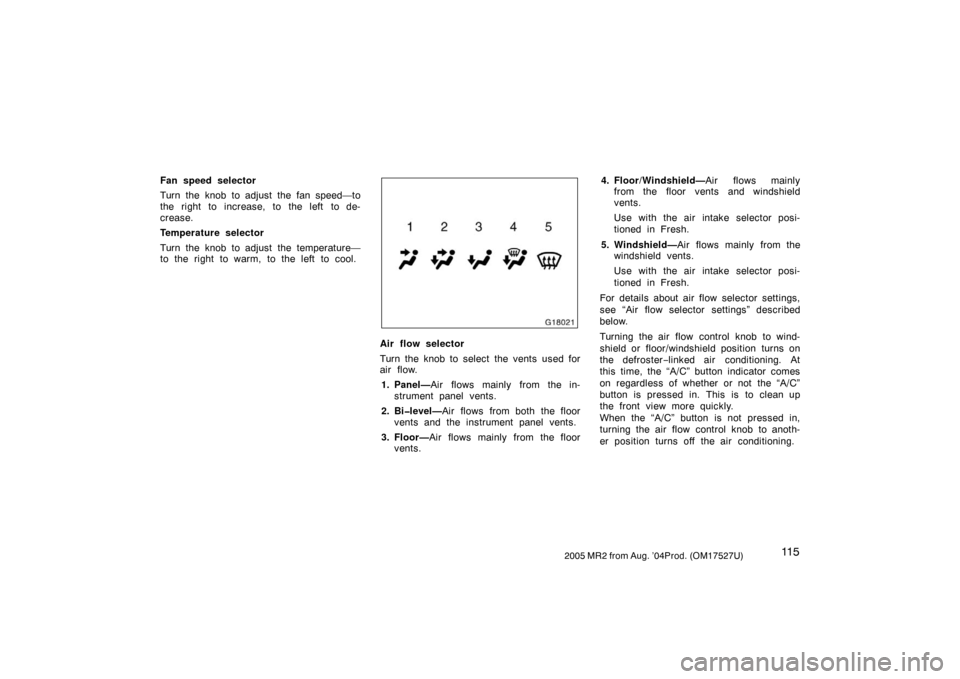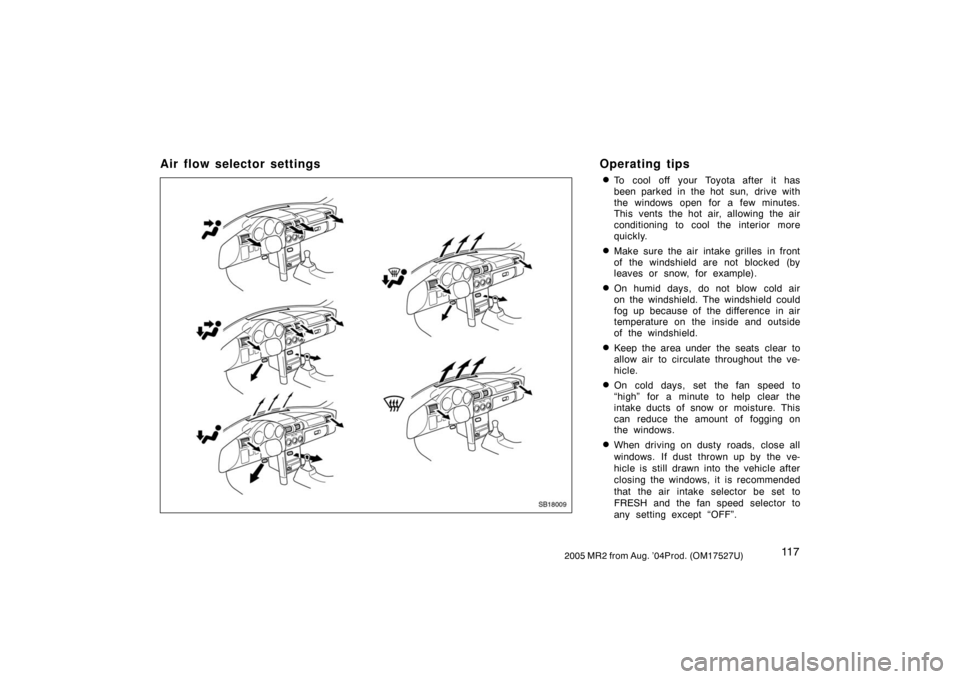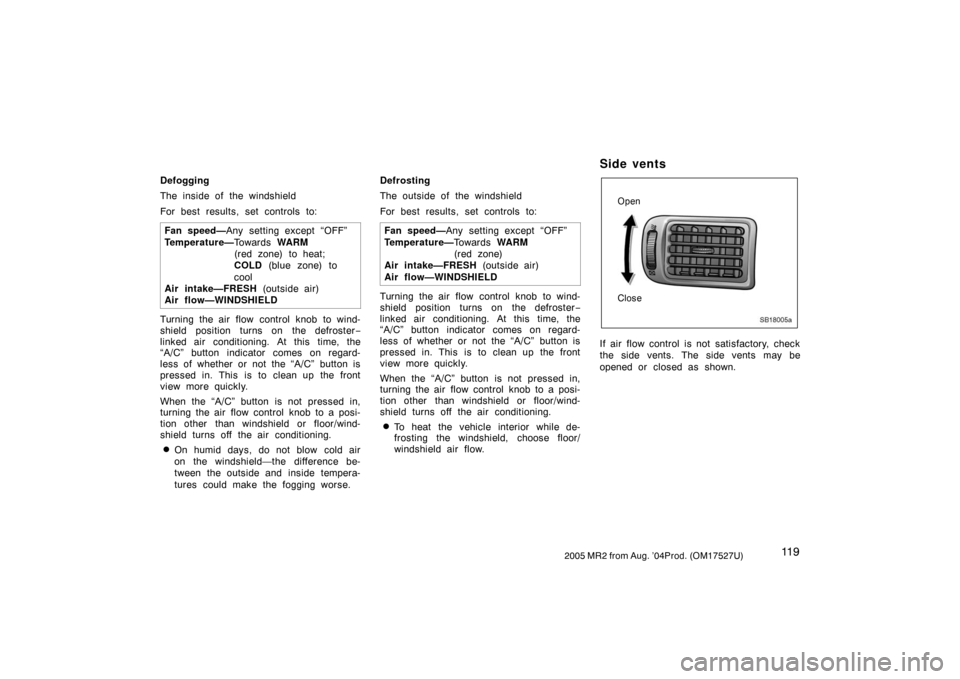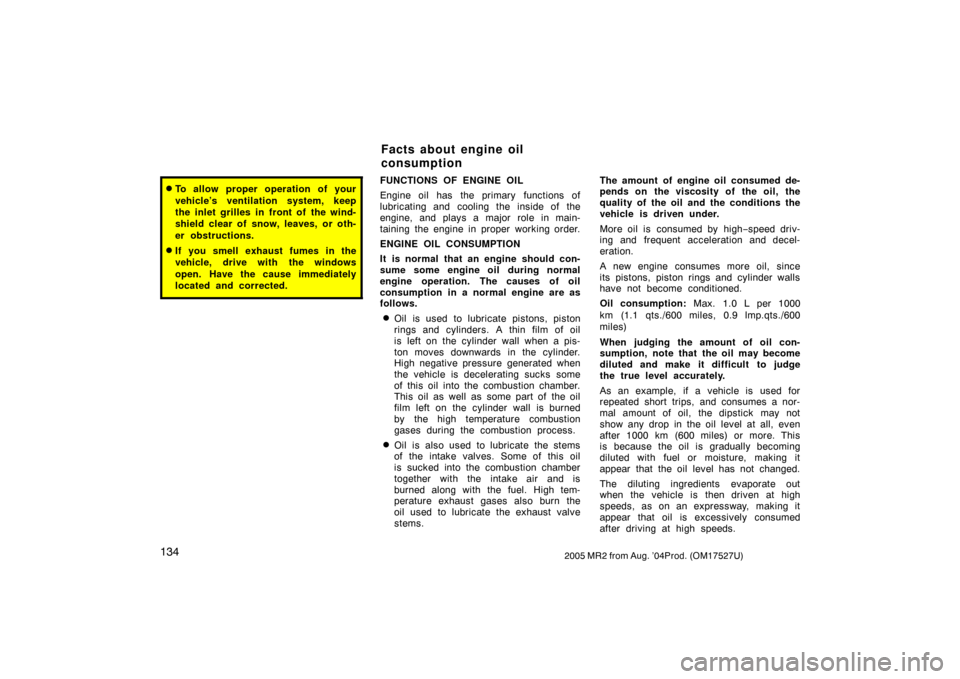Page 121 of 259
11 32005 MR2 from Aug. ’04Prod. (OM17527U)
OPERATION OF INSTRUMENTS AND
CONTROLS
Air conditioning system
Controls11 4 . . . . . . . . . . . . . . . . . . . . . . . . . . . . . . . . . . . . . . . . . . . . . . . . . . .
Air flow selector settings11 7 . . . . . . . . . . . . . . . . . . . . . . . . . . . . . . . . . . . . .
Operating tips11 7 . . . . . . . . . . . . . . . . . . . . . . . . . . . . . . . . . . . . . . . . . . . . . .
Side vents11 9 . . . . . . . . . . . . . . . . . . . . . . . . . . . . . . . . . . . . . . . . . . . . . . . . .
SECTION 1� 9
Page 123 of 259

11 52005 MR2 from Aug. ’04Prod. (OM17527U)
Fan speed selector
Turn the knob to adjust the fan speed—to
the right to increase, to the left to de-
crease.
Temperature selector
Turn the knob to adjust the temperature—
to the right to warm, to the left to cool.
G18021
Air flow selector
Turn the knob to select the vents used for
air flow.
1. Panel—Air flows mainly from the in-
strument panel vents.
2. Bi�level—Air flows from both the floor
vents and the instrument panel vents.
3. Floor—Air flows mainly from the floor
vents.4. Floor/Windshield—Air flows mainly
from the floor vents and windshield
vents.
Use with the air intake selector posi-
tioned in Fresh.
5. Windshield—Air flows mainly from the
windshield vents.
Use with the air intake selector posi-
tioned in Fresh.
For details about air flow selector settings,
see “Air flow selector settings” described
below.
Turning the air flow control knob to wind-
shield or floor/windshield position turns on
the defroster−linked air conditioning. At
this time, the “A/C” button indicator comes
on regardless of whether or not the “A/C”
button is pressed in. This is to clean up
the front view more quickly.
When the “A/C” button is not pressed in,
turning the air flow control knob to anoth-
er position turns off the air conditioning.
Page 124 of 259
11 62005 MR2 from Aug. ’04Prod. (OM17527U)
G18023
Air intake selector
Move the lever to select the air source.
1. Recirculate—Recirculates the air inside
the vehicle.
2. Fresh—Draws outside air into the sys-
tem.“A/C” button
To turn on the air conditioning, press the
“A/C” button. The “A/C” button indicator
will come on. To turn the air conditioning
off, press the button again.
If the “A/C” button indicator flashes, there
is a problem in the air conditioning system
and the air conditioning automatically
shuts off. If this happens, take your ve-
hicle to a Toyota dealer for service.
Page 125 of 259

11 72005 MR2 from Aug. ’04Prod. (OM17527U)
Air flow selector settings Operating tips
�To cool off your Toyota after it has
been parked in the hot sun, drive with
the windows open for a few minutes.
This vents the hot air, allowing the air
conditioning to cool the interior more
quickly.
�Make sure the air intake grilles in front
of the windshield are not blocked (by
leaves or snow, for example).
�On humid days, do not blow cold air
on the windshield. The windshield could
fog up because of the difference in air
temperature on the inside and outside
of the windshield.
�Keep the area under the seats clear to
allow air to circulate throughout the ve-
hicle.
�On cold days, set the fan speed to
“high” for a minute to help clear the
intake ducts of snow or moisture. This
can reduce the amount of fogging on
the windows.
�When driving on dusty roads, close all
windows. If dust thrown up by the ve-
hicle is still drawn into the vehicle after
closing the windows, it is recommended
that the air intake selector be set to
FRESH and the fan speed selector to
any setting except “OFF”.
SB18009
Page 126 of 259

11 82005 MR2 from Aug. ’04Prod. (OM17527U)
�If following another vehicle on a dusty
road, or driving in windy and dusty
conditions, it is recommended that the
air intake selector be temporarily set to
RECIRCULATE, which will close off the
outside passage and prevent outside
air and dust from entering the vehicle
interior.Heating
For best results, set controls to:
Fan speed—Any setting except “OFF”
Temperature—To w a r d s WARM
(red zone)
Air intake—FRESH (outside air)
Air flow—FLOOR
Air conditioning—OFF
�For quick heating, select recirculated
air for a few minutes. To keep the
windows from fogging. select fresh af-
ter the vehicle interior has been
warmed.
�Press the “A/C” button on for dehumidi-
fied heating.
�Choose floor/windshield air flow to heat
the vehicle interior while defrosting or
defogging the windshield.Air conditioning
For best results, set controls to:
Fan speed—Any setting except “OFF”
Temperature—To w a r d s COLD
(blue zone)
Air intake—FRESH (outside air)
Air flow—PANEL
Air conditioning—ON
�For quick cooling, move the air intake
selector to recirculate for a few min-
utes.
Ventilation
For best results, set controls to:
Fan speed—Any setting except “OFF”
Temperature—To w a r d s COLD
(blue zone)
Air intake—FRESH (outside air)
Air flow—PANEL
Air conditioning—OFF
Page 127 of 259

11 92005 MR2 from Aug. ’04Prod. (OM17527U)
Defogging
The inside of the windshield
For best results, set controls to:
Fan speed—Any setting except “OFF”
Temperature—To w a r d s WARM
(red zone) to heat;
COLD (blue zone) to
cool
Air intake—FRESH (outside air)
Air flow—WINDSHIELD
Turning the air flow control knob to wind-
shield position turns on the defroster−
linked air conditioning. At this time, the
“A/C” button indicator comes on regard-
less of whether or not the “A/C” button is
pressed in. This is to clean up the front
view more quickly.
When the “A/C” button is not pressed in,
turning the air flow control knob to a posi-
tion other than windshield or floor/wind-
shield turns off the air conditioning.
�On humid days, do not blow cold air
on the windshield—the difference be-
tween the outside and inside tempera-
tures could make the fogging worse.Defrosting
The outside of the windshield
For best results, set controls to:
Fan speed—Any setting except “OFF”
Temperature—To w a r d s WARM
(red zone)
Air intake—FRESH (outside air)
Air flow—WINDSHIELD
Turning the air flow control knob to wind-
shield position turns on the defroster−
linked air conditioning. At this time, the
“A/C” button indicator comes on regard-
less of whether or not the “A/C” button is
pressed in. This is to clean up the front
view more quickly.
When the “A/C” button is not pressed in,
turning the air flow control knob to a posi-
tion other than windshield or floor/wind-
shield turns off the air conditioning.
�To heat the vehicle interior while de-
frosting the windshield, choose floor/
windshield air flow.
Side vents
SB18005a
Open
Close
If air flow control is not satisfactory, check
the side vents. The side vents may be
opened or closed as shown.
Page 142 of 259

1342005 MR2 from Aug. ’04Prod. (OM17527U)
�To allow proper operation of your
vehicle’s ventilation system, keep
the inlet grilles in front of the wind-
shield clear of snow, leaves, or oth-
er obstructions.
�If you smell exhaust fumes in the
vehicle, drive with the windows
open. Have the cause immediately
located and corrected.
FUNCTIONS OF ENGINE OIL
Engine oil has the primary functions of
lubricating and cooling the inside of the
engine, and plays a major role in main-
taining the engine in proper working order.
ENGINE OIL CONSUMPTION
It is normal that an engine should con-
sume some engine oil during normal
engine operation. The causes of oil
consumption in a normal engine are as
follows.
�Oil is used to lubricate pistons, piston
rings and cylinders. A thin film of oil
is left on the cylinder wall when a pis-
ton moves downwards in the cylinder.
High negative pressure generated when
the vehicle is decelerating sucks some
of this oil into the combustion chamber.
This oil as well as some part of the oil
film left on the cylinder wall is burned
by the high temperature combustion
gases during the combustion process.
�Oil is also used to lubricate the stems
of the intake valves. Some of this oil
is sucked into the combustion chamber
together with the intake air and is
burned along with the fuel. High tem-
perature exhaust gases also burn the
oil used to lubricate the exhaust valve
stems.The amount of engine oil consumed de-
pends on the viscosity of the oil, the
quality of the oil and the conditions the
vehicle is driven under.
More oil is consumed by high−speed driv-
ing and frequent acceleration and decel-
eration.
A new engine consumes more oil, since
its pistons, piston rings and cylinder walls
have not become conditioned.
Oil consumption: Max. 1.0 L per 1000
km (1.1 qts./600 miles, 0.9 lmp.qts./600
miles)
When judging the amount of oil con-
sumption, note that the oil may become
diluted and make it difficult to judge
the true level accurately.
As an example, if a vehicle is used for
repeated short trips, and consumes a nor-
mal amount of oil, the dipstick may not
show any drop in the oil level at all, even
after 1000 km (600 miles) or more. This
is because the oil is gradually becoming
diluted with fuel or moisture, making it
appear that the oil level has not changed.
The diluting ingredients evaporate out
when the vehicle is then driven at high
speeds, as on an expressway, making it
appear that oil is excessively consumed
after driving at high speeds.
Facts about engine oil
consumption
Page 154 of 259

1462005 MR2 from Aug. ’04Prod. (OM17527U)
—Glossary of tire terminology
Ti r e relat ed ter mMeaning
Cold tire inflation pressure
tire inflation pressure when the vehicle has been parked for at leas t 3 hour s
or more, or it has not been driven more than 1.5 km or 1 mile under that
condition
Maximum inflation pressurethe maximum cold inflation pressure to which a tire may be inflated and it is
shown on the sidewall of the tire
Recommended inflation pressurecold tire inflation pressure recommended by a manufacturer
Accessory weight
the combined weight (in excess of those standard items which may be replaced)
of automatic transmission, power steering, power brakes, power windows, pow-
er seats, radio, and heater, to the extent that these items are available as
factory−installed equipment (whether installed or not)
Curb weight
the weight of a motor vehicle with standard equipment including the maximum
capacity of fuel, oil, and coolant, and, if so equipped, air conditioning and addi-
tional weight optional engine
Maximum loaded vehicle weight
t he sum of —
(a) curb weight;
(b) accessory weight;
(c) vehicle capacity weight; and
(d) production options weight
Normal occupant weight68 kg (150 lb.) times the number of occupants specified in the second column
of Table 1 that follows